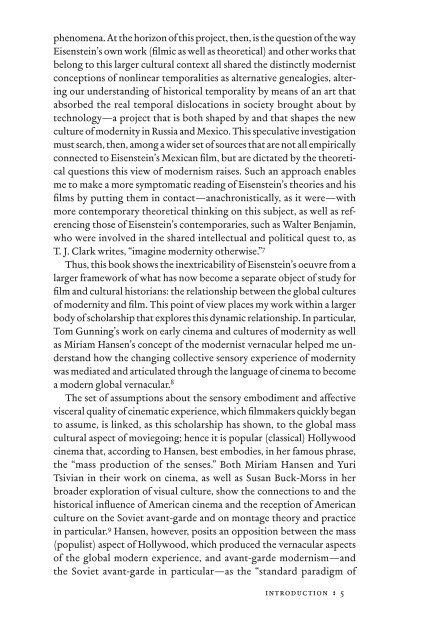In Excess: Sergei Eisentein's Mexico - Cineclub
In Excess: Sergei Eisentein's Mexico - Cineclub
In Excess: Sergei Eisentein's Mexico - Cineclub
Create successful ePaper yourself
Turn your PDF publications into a flip-book with our unique Google optimized e-Paper software.
phenomena. At the horizon of this project, then, is the question of the way<br />
Eisenstein’s own work (fi lmic as well as theoretical) and other works that<br />
belong to this larger cultural context all shared the distinctly modernist<br />
conceptions of nonlinear temporalities as alternative genealogies, altering<br />
our understanding of historical temporality by means of an art that<br />
absorbed the real temporal dislocations in society brought about by<br />
technology—a project that is both shaped by and that shapes the new<br />
culture of modernity in Russia and <strong>Mexico</strong>. This speculative investigation<br />
must search, then, among a wider set of sources that are not all empirically<br />
connected to Eisenstein’s Mexican fi lm, but are dictated by the theoretical<br />
questions this view of modernism raises. Such an approach enables<br />
me to make a more symptomatic reading of Eisenstein’s theories and his<br />
fi lms by putting them in contact—anachronistically, as it were—with<br />
more contemporary theoretical thinking on this subject, as well as referencing<br />
those of Eisenstein’s contemporaries, such as Walter Benjamin,<br />
who were involved in the shared intellectual and political quest to, as<br />
T. J. Clark writes, “imagine modernity otherwise.” 7<br />
Thus, this book shows the inextricability of Eisenstein’s oeuvre from a<br />
larger framework of what has now become a separate object of study for<br />
fi lm and cultural historians: the relationship between the global cultures<br />
of modernity and fi lm. This point of view places my work within a larger<br />
body of scholarship that explores this dynamic relationship. <strong>In</strong> particular,<br />
Tom Gunning’s work on early cinema and cultures of modernity as well<br />
as Miriam Hansen’s concept of the modernist vernacular helped me understand<br />
how the changing collective sensory experience of modernity<br />
was mediated and articulated through the language of cinema to become<br />
a modern global vernacular. 8<br />
The set of assumptions about the sensory embodiment and affective<br />
visceral quality of cinematic experience, which fi lmmakers quickly began<br />
to assume, is linked, as this scholarship has shown, to the global mass<br />
cultural aspect of moviegoing; hence it is popular (classical) Hollywood<br />
cinema that, according to Hansen, best embodies, in her famous phrase,<br />
the “mass production of the senses.” Both Miriam Hansen and Yuri<br />
Tsivian in their work on cinema, as well as Susan Buck-Morss in her<br />
broader exploration of visual culture, show the connections to and the<br />
historical infl uence of American cinema and the reception of American<br />
culture on the Soviet avant-garde and on montage theory and practice<br />
in particular. 9 Hansen, however, posits an opposition between the mass<br />
(populist) aspect of Hollywood, which produced the vernacular aspects<br />
of the global modern experience, and avant-garde modernism—and<br />
the Soviet avant-garde in particular—as the “standard paradigm of<br />
introduction : 5


